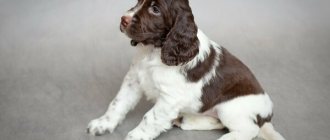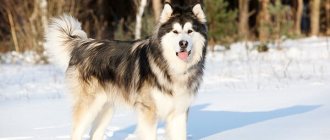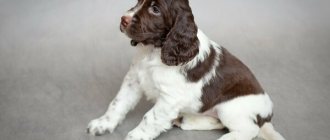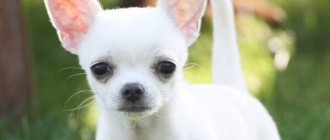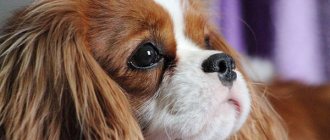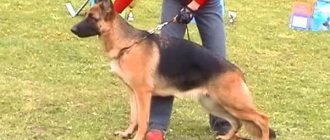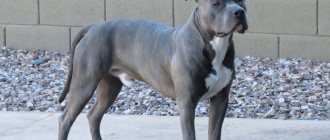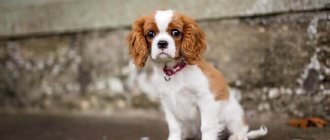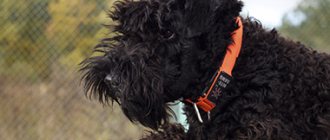Spaniels are a group of gun dogs whose main purpose is to search for game and retrieve it after shooting.
Some of them are universal: in addition to poultry, they are also used to hunt rabbits, hares, foxes or ungulates.
Their elegant appearance and friendly disposition have contributed to the use of spaniels as pets.
Almost all of them can live both in a house and in a city apartment, however, when choosing and keeping a pet, you need to take into account the breed characteristics.
Short description
Most spaniels are small or medium-sized dogs, the most characteristic external features of which are long floppy ears and a good-natured look of expressive eyes .
Spaniels have coats of different lengths: short on the head and front of the legs, medium length on the body and long in the fringe area.
The body is square or close to square. However, some spaniels, such as Clumbers or Sussexes, have a stretched format, which makes them look rather squat.
The head is proportional to the body, with a flattened or slightly rounded skull and a square muzzle that almost does not taper towards the nose.
The neck is of medium length, with a beautiful curve and proud carriage, the back is straight and level, the chest is well developed, the stomach is slightly tucked.
The limbs are parallel, strong, moderately muscular.
The tail is carried in line with the back or slightly lower. Representatives of many breeds have traditionally docked tails, as this helps to avoid injury during hunting.
The coat of land spaniels is silky and soft.
A characteristic feature of water spaniels is their short hair, which forms small tight curls that protect the dog from water, dirt and adverse weather conditions..
Kooikerhondje
Another representative of the ancient family is the Dutch spaniel. Hailing from the land of lakes, the dog has the unique ability to attract ducks. It is considered the most ancient breed of the family, about which written evidence is kept, and it is depicted on the canvases of great artists.
According to the description, these are proportional, thin dogs, with an elongated muzzle and a smooth forehead line. The neck is muscular and raised high. The body is oblong. At the withers, dogs barely reach 30 cm. Weight is about 13 kg. The color of the dogs is noble two-tone golden and white. A white stripe cuts across the forehead. The ears must have black fringe in the form of earrings.
History of the breed
According to the generally accepted version, these dogs were bred in Spain in the early Middle Ages, from where they came to other European countries.
Edward of Norwich, Second Duke of York, in his treatise on hunting “The Master of Game”, written in 1406–1413, pointed out that just as all greyhounds originate from England or Scotland, so spaniels originate from Spain .
And in the 16th century, the British naturalist John Caius wrote that most spaniels are white, and if they have spots, they are reddish or tan in color.
He also noted that a breed of spaniels had recently been bred in France, the representatives of which had a white and black speckled color.
In addition to the Spanish version of the origin of spaniels, there are also Celtic and Roman hypotheses.
According to the first of them, the ancestors of modern European spaniels came to the British Isles back in 900 BC. together with a branch of Celtic tribes who moved from the territory of modern Spain to Cornwall, Wales, England and Ireland.
According to another hypothesis, spaniels were brought to Britain by the ancient Romans, who, when they set out to conquer new lands, took with them not only large fighting dogs, but also small hunting dogs.
There is another version, according to which the first spaniels are of Far Eastern origin and are related to such breeds as Pekingese, pugs and Shih Tzu.
They came to Europe around the 14th century and very quickly became popular as hunting and, later, boudoir dogs.
The main breeding work on developing modern spaniel breeds began in the 18th and 19th centuries.
Most of these dogs were bred in the second half of the 19th century, and this process took place not only in Britain, but also in Germany, France and Holland.
Thanks to targeted breeding work, spaniel breeds were bred there that were better able to work in local natural and climatic conditions than dogs of English origin..
Historical reference
The first information about dogs, united by the term “spaniel breed,” dates back to ancient times. In the era of Alexander the Great, a coin was in use, on the reverse of which a dog was minted, very similar to modern representatives.
Spaniel is a charming pet for the whole family
Spain is considered to be the homeland, which is reflected in the name. It was the spaniels that kept the crusaders company, as they established themselves as hardy and brave animals. Gradually, their charming appearance became the reason for increased attention from the aristocracy. Spaniels moved from being a walking and hunting group into the decorative category.
What types exist
English cocker spaniel
English Cocker Spaniels are beautiful dogs with a noble appearance, distinguished by their devotion to their owners, love for children, as well as intelligence, intelligence and good trainability .
The colors of these dogs can be different, but mostly monochromatic - red, black, white, brown and others.
According to the owners, these are not very high-maintenance dogs. Both puppies and adult dogs are relatively easy to care for. Except that sometimes a haircut may be required.
English cockers have not lost their hunting skills. They are hardy, efficient and have an excellent sense of smell.
There are both standard representatives of the breed and a mini variety.
American Cocker Spaniel
These small dogs with a cute and elegant appearance are distinguished by long, flowing hair that forms fluffy feathers on the legs and a kind of skirt on the stomach..
By nature, they are people-friendly and affectionate animals that love children and love to play with them.
English Springer Spaniel
English Springer Spaniels are medium-sized dogs, distinguished by obedience and a penchant for sports and outdoor games .
Their main purpose is to jump out of ambush and scare away game during the hunt. English Springers are also well suited for the role of family pets, however, you need to remember that they make unreliable watchmen.
Welsh Springer Spaniel
The Welsh Springer Spaniel is a cute white and red dog with thick, silky fur and expressive dark eyes. Welsh Springers are famous as excellent hunters; they are strong, hardy, excellent swimmers and willingly return shot game.
At home they are affectionate and friendly.
Clumber Spaniel
The Clumber Spaniel is the most massive and heaviest of the spaniels. A squat white dog with reddish or fawn markings and a rather heavy head, but proportionate to the body, with not too long ears and a phlegmatic look.
It works somewhat slower on game than other spaniels, but is stubborn and persistent when tracking down prey . By nature he is calm, friendly and moderately sociable.
Sussex Spaniel
The Sussex Spaniel was bred as a gun dog that could work in dense woodland .
Outwardly, it somewhat resembles a Clumber Spaniel, but is shorter in stature and its color is not white with reddish specks, but reddish-brown with a golden sheen.
By nature, the Sussex Spaniel is phlegmatic . He is calm, even-tempered, friendly to other dogs and people, and gets along well with children.
Field Spaniel
Field Spaniels are good-natured dogs of black, brown or roan coloring with a melancholic look and a thick, silky and shiny coat. These are good companions and family favorites - loyal, smart, obedient.
They are affectionate and good with other dogs and people..
Breton epañol
The Breton Espanole is a stocky, medium-sized dog with a slightly shortened muzzle and a straight or slightly wavy fine coat. Color: white-red, white-black, white-chestnut.
Brenon Spaniards are considered excellent gundogs: they start working on game early and have excellent retrieving qualities..
German Wachtelhund
The German Wachtelhund is a dog of medium height with wavy, slightly elongated hair. It is considered a universal hunting dog; it can work both on feathers and on animals, including large ungulates.
The main colors are red, brown, red and white, brown and white with specks . Wachtelhunds do not tolerate life in a confined space and get bored without work, so they are usually only kept by huntsmen and hunters.
Kooikerhondje
A small white and red dog, which in Holland is traditionally used for duck hunting.
This is a cheerful, friendly, calm and intelligent dog who loves to please his owner.
American Water Spaniel
A muscular and strong medium-sized dog with a dense coat that forms many small curls. Bred in Wisconsin, used for hunting birds and hares.
Swims well and readily retrieves game from the water.
Irish Water Spaniel
The Irish Water Spaniel is a large and strong dog with a stocky build, known for its physical strength, endurance and excellent fetching skills.
The main external feature is the curly coat of a reddish-brown color with a purple tint . On the head it creeps over the eyes, forming something like a fluffy cap.
Wetterhun
It was bred in the 17th century in Holland, where it was mainly used for hunting otters . The Wetterhun is a medium-sized dog with a strong, square body.
Its thick, dense coat forms many curls and is slightly oily to the touch. The most typical colors are black, brown, black and white, brown and white.
Russian hunting spaniel
The Russian hunting spaniel is the only gun breed of Russian origin. The coat is long, straight or slightly wavy, the color is black, brown, red, and also bicolor or tricolor.
These dogs are known as skilled hunters, working mainly by feather . They are calm, loyal and obedient, but when hunting they show interest and persistence, they swim and dive well.
King Charles Spaniel
King Charles Spaniels are small dogs with a small, short, upturned muzzle, long soft hair and wide-set eyes, giving them a characteristic “toy” appearance.
The standard allows only four colors: black and tan, ruby, bleinheim (white and red) and tricolor.
Cavalier King Charles Spaniel
Cavalier King Charles Spaniels are toy dogs very similar to King Charles Spaniels, except that their muzzles are not short and upturned, but elongated.
In addition, the eyes of the Cavalier King Charles are set closer and not so protruding.
Continental Toy Spaniel
Continental Toy Spaniels are small decorative dogs with motley colors and cute, slightly pointed faces.
Depending on the shape of the ears, they are divided into two varieties - Papillon (with erect ears) and Phalene (dropping ears, but set quite high, higher than those of most spaniels).
Tibetan Spaniel
Only their name has something in common with real spaniels. Tibetan spaniels are small, agile dogs with an elongated body, a small head and a tail in a fluffy ring.
The muzzle is short and, as a rule, with a slight undershot . Any color is acceptable, but the most valuable is black with a light spot on the chest.
Japanese Chin
A small beautiful dog, similar to a dwarf spaniel, with a flattened muzzle and a touching look of bulging dark eyes. The coat is long, thick and straight, and the most typical colors are black and white and reddish white.
Regardless of color, the Japanese Chin must have a white mark on its forehead .
Common Spaniel Groups
Terriers: all breeds, what varieties there are
The main division is hunting and decorative. The main classification of spaniel varieties was carried out in 1800, then two groups of dogs were distinguished according to the criterion of body weight:
- Field. The average weight is about 9 kg, they were also called English.
- Cocker spaniels. Weight is about 4.5-5 kg.
According to the type of coat they can be divided into short- and long-haired.
Spaniels are popular all over the world
Character traits
All spaniels, with the exception of dwarf ones, are excellent hunters: they confidently find game both by scent and by upper instinct, and after shooting they bring it to their owner.
At home, they are playful, affectionate and good-natured . They are good with children and have a strong attachment to their owners.
They are not aggressive towards strangers, but some of them prefer to be wary of strangers.
Most spaniels, after timely socialization and with proper upbringing, are quite capable of getting along with another dog or cat, but some of them will show aggression towards rodents or birds.
Spaniels need quite long walks, as well as outdoor games and runs without a leash..
Representatives of some breeds, such as water spaniels, also cannot do without access to a pool or any other body of water where the dog can swim whenever he wants.
Expert opinion
Kozhevin Semyon Kirillovich
Expert dog handler.
“Spaniels are affectionate and friendly pets that get along well with children and are not aggressive towards strangers. They are obedient, intelligent and well trained. When hunting, spaniels work with interest, have a good sense of smell and good retrieval abilities. However, you need to take into account that not all of them are suitable as a pet: representatives of some breeds get bored without hunting and do not like to live in a confined space.”
Welsh Springer
A graceful native of Great Britain, the Welsh Springer Spaniel is believed to have been bred in the 17th century - there is even documentary evidence of the existence of the species at that time in the form of artistic paintings depicting this dog. The general impression that the Welsh Springer leaves when you first meet him is that he is a strong, hardy, noble hunting dog. It can grow up to 48 cm at the withers and weigh up to 20 kg .
The build of this type of spaniel is compact and strong. The chest protrudes forward. The head is dome shaped. The muzzle is medium. The ears are long, wide, pear-shaped, and fit tightly to the cheekbones. The body is covered with soft, straight, thick hair, which can protect the dog from exposure to cold, water, and thorns. The characteristic color is red and white with or without spots.
Welsh Springers are smart, quick-witted, and friendly. They are easy to train. If raised correctly, they become obedient and flexible. In the absence of education, hunting habits can become a problem . They are loyal to children and other animals, including dogs. The lifespan of Welsh Springers is 12-14 years. Cost in dollars – 1200-1400.
Advantages and disadvantages
pros:
- Beautiful and noble appearance.
- Kindness towards people.
- Love for children.
- Good hunting qualities.
- Endurance and ability to adapt.
- Unpretentiousness in content.
- Loyalty to the owner.
- Mobility and playfulness.
Minuses:
- They need a lot of physical activity, swimming and long walks.
- The long floppy ears collect dust, dirt, plant seeds and even external parasites while walking or hunting.
- Some spaniels require trimming or a special haircut.
- The coat of water spaniels has a characteristic oily odor and feels greasy to the touch.
- Some spaniels can be aggressive towards smaller pets.
- Not all breeds are suitable to be kept as a pet or as a show dog.
- Not suitable for protection.
Spaniels are intelligent and artistic, making them ideal for sports that require agility and jumping ability.
Wachtelhund
Another representative of the German Spaniel or Wachtelhund family. A fairly large dog, reaching 54 cm at the withers, it works mainly on waterfowl, in swampy and wooded areas. The breed is little known outside Germany.
Provided that the owners often go outdoors, it does not feel bad in urban conditions. In appearance it is a bit like a Scottish Setter, with wavy, long brown fur. Brown color is common. The character matches the breed.
Nutritional Features
Spaniels are unpretentious in nutrition: they willingly eat both home-cooked food and ready-made food. At the same time, it is very important that the food is of high quality and complete.
If it is ready-made dry food, then it must be at least premium class and at the same time appropriate for the size, age, physical condition and activity of the pet..
With natural feeding, approximately 50% of the diet should consist of lean muscle meat and offal, to which are added porridge, boiled or raw vegetables, fermented milk products, as well as vitamins and minerals.
Considering that most spaniels are prone to overeating, you need to make sure that the pet receives only its portion.
You should not supplement him between feedings, or allow him to beg for food near the table or look for “supplements” to his diet on the street.
Health and major diseases, life expectancy
Most spaniels are distinguished by good health and stamina.
However, some of these dogs may be susceptible to a number of diseases such as:
- Inflammatory diseases of the ears.
- Eye diseases such as cataracts, glaucoma, retinal atrophy or dystrophy.
- Turn of the century.
- Joint dysplasia.
- Cardiovascular diseases.
- Autoimmune diseases.
- Allergy.
- Epilepsy.
Toy spaniels may also be predisposed to specific diseases, such as bleeding disorders due to congenital platelet deficiency, hydrocephalus, and habitual dislocation of the knee joint.
The life expectancy of spaniels, depending on the breed, ranges from 10 to 16 years..
Dog education and training
All spaniels need timely socialization and proper education and training. It is very important to decide from the very beginning what the dog will be allowed to do and what not. You need to treat your pet kindly, without rudeness or coercion.
NOTE!
During training, you need to follow the sequence: learn simpler commands first, and then more complex ones.
It is also very important not to miss classes without good reason, since the pet may forget the skills over time and then he will have to be taught everything again.
If desired, the owner can teach the spaniel to track and serve game, but it is better to conduct classes on training a hunting spaniel not independently, but under the guidance of an experienced instructor.
In addition to the basic spaniel training course, you can also teach circus tricks or take a course in agility training or, for example, freestyle.
Features of care
The coat should be brushed 1-2 times a week and washed as needed, using shampoo for long-haired dogs.
Representatives of some breeds require a show or hygienic haircut . You can trim your pet either in a salon or on your own, of course, if you have the necessary tools and skills.
The dog's ears and eyes should be examined and, if dirty, cleaned with special drops or lotions. You can clean your pet's teeth with a brush and dog toothpaste.
Although, usually, it is enough to simply feed the spaniel fairly solid food and let him chew on treats intended to clean his teeth.
It is recommended to trim the claws only when they grow excessively; in this case, you need to very carefully cut off the area that turns inward with a nail clipper.
How to choose?
Regardless of whether the dog is purchased for hunting, exhibitions, or as a pet, you only need to purchase a spaniel with documents - from a kennel or from a breeder.
If a dog is taken for work, then you need to make sure that its puppy's have field testing diplomas . And for show-class puppies, it is desirable that their ancestors have championship titles.
When choosing a puppy, you need to pay attention to its compliance with the requirements of the standard. Moreover, this applies not only to exterior features, but also to character and temperament.
IMPORTANT!
The baby should be friendly to people, playful and moderately inquisitive.
Shows of aggression or cowardice are unacceptable, as such behavior is considered breeding.
The puppy should look completely healthy: there should be no skin rashes or discharge from the eyes, nose or ears..
A healthy baby spaniel looks strong and moderately well-fed; he should not have protruding ribs or a bloated abdomen, indicating problems with digestion or the presence of internal parasites.
